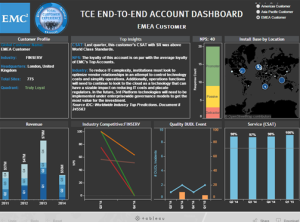With any business, there is always risk of failure. Failure is more certain when a company does not adapt to market and customer needs – think Blockbuster Video. But what do companies that thrive, such as JetBlue and Apple, have in common that allows them to grow and separate from the competition?
These successful companies all have the presence of a customer-centric strategy.
A customer-centric strategy requires three fundamental elements:
- Personalized customer connections
- Agile methods to meaningfully act on customer data
- Commitment to continuous improvement
Personalized customer connections
Companies must be willing to implement new types of listening to engage with customers when and where it matters most. Phone and web surveys are important, but not enough to get real-time understanding of what’s going on with a customer and take action. In today’s digital world, companies must integrate surveys into a more holistic strategy, which includes dynamic listening platforms such as social media.
JetBlue stands out for its proactive efforts to respond to customers via Twitter. I especially like the story of Ben Kepes who frequently journeys between his home in New Zealand and the US, normally through Star Alliance airlines. Yet, on his first trip with JetBlue, he decided to tweet out to the company. He notes that, “[w]ithin seconds, I had a response from the company wishing me a good journey. I responded to JetBlue’s social team…making a bit of a random comment about the fact that airlines don’t recognize, nor have any visibility, over individual passengers’ travel habits or status…so I was a little surprised to have a message from JetBlue wishing me a good flight and telling me to await a nice surprise at check-in…and was impressed to see that the JetBlue team had upgraded me to a first class seat for my short hop.”

Agile methods to act on customer data and translate it to meaningful action
Once you’ve established effective connections and listening posts, you must effectively leverage the data to drive meaningful actions for customers. In EMC’s personal Big Data journey, we uncovered two key takeaways:
- The need to build out a scalable platform for structured and unstructured data
- The need to shift the responsibility of the “value” of the data from “IT” to the business
Developing a true company-wide Big Data Lake will be the most effective tool to break down internal silos and encourage maximum customer impact throughout their end-to-end experience.
 This learning allows us to deliver a more personalized service experience. For example, visualization dashboards bring together a single comprehensive view of key customer data, including revenue, competitive perception, loyalty, customer service satisfaction and product quality. Having this type of insight at our fingertips means we can start conversations at a point of true value, knowing what is going on in an individual customer’s environment so we can take swift corrective action when issues arise.
This learning allows us to deliver a more personalized service experience. For example, visualization dashboards bring together a single comprehensive view of key customer data, including revenue, competitive perception, loyalty, customer service satisfaction and product quality. Having this type of insight at our fingertips means we can start conversations at a point of true value, knowing what is going on in an individual customer’s environment so we can take swift corrective action when issues arise.
This agile data methodology, which relies on our corporate data lake, is a critical differentiator of our customer-centric approach and something that other companies should consider for the future.
Commitment to continuous improvement
Having a culture committed to continuous improvement is paramount. While listening and data will help reveal areas that require transformation, it’s the people in your business who are willing to embrace change to improve the customer experience – essential to long-term success.
Apple’s constant push to innovate in ways that excite customers without compromising its core values is why it has successfully pushed out competitors across numerous product areas—such as its recent domination of the mobile payment market, where its proprietary fingerprint technology has made the experience so easy that nearly two-thirds of all contactless payments are now made with Apple Pay.
The aspiration to be better starts with whether or not your employees are committed to the same goal. Tim Cook, Apple CEO, describes their culture in Fast Company: “We’ve turned up the volume on collaboration because it’s so clear that in order for us to be incredibly successful we have to be the best collaborators in the world. The magic of Apple, from a product point of view, happens at this intersection of hardware, software, and services.” Additionally, he notes how the company can always do better: “We’ve made errors in the past, and we’ll never be perfect. Fortunately, we have the courage to admit it and correct it.”
As a business leader, how can you apply the lessons from customer-centric companies, and those that failed to focus on the customer, to ensure you stay ahead of the competition and position yourself for long-term success?
In our own personal journey, EMC has learned that it is critical to look at the total end to end customer experience, creating personal customer connections through effective listening posts, using agile methods to meaningfully act on customer data, and building a culture of continuous improvement.
And today, our Federation companies bring together customers, partners and employees for a Total Customer Experience Global Celebration in honor of the industry-wide Customer Experience Day.
I want to personally thank our customers for your patience and partnership. EMC plans to be around for a very long time and we know that this is possible only if we stay the course and never lose sight that the CUSTOMER ALWAYS COMES FIRST.